 |
 |
 |
 Vallarta Living | Art Talk | December 2007 Vallarta Living | Art Talk | December 2007  
Having Some Designs on Success
 Pablo Jaime Sainz - San Diego Union-Tribune Pablo Jaime Sainz - San Diego Union-Tribune
go to original

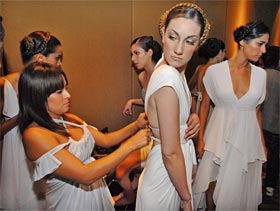
| | Models showed off locally produced creations at a September show at the Grand Hotel in Tijuana. (David Maung/Union-Tribune) | 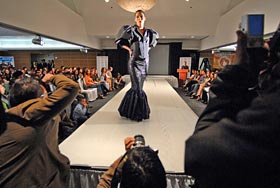
| | A dress created by Tijuana designer Iván Rodríguez was modeled during a fashion show at the Marriott Hotel in Tijuana in November. (David Maung/Union-Tribune) | 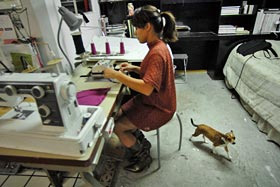
| | Designer Ximena Valero worked in her Tijuana studio. A native of the city, she has worked in New York and plans to return to Los Angeles next month. (David Maung/Union-Tribune) | 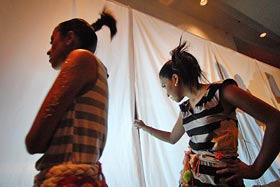
| | A Tijuana model waited backstage during a show at Tijuana's Grand Hotel. One local designer says that fashion market is growing in the region. (David Maung/Union-Tribune) |
Tijuana – It was a recent Sunday afternoon and some 20 Tijuana models – men and women – sported the creations of several of this city's fashion designers.

The runways of the fourth annual Tijuana Fashion Week highlighted the diversity in this field.

There were designs created by young women just learning the trade, as well as those from Ximena Valero, one of the best-known Tijuana designers in the United States.

“This event was a display of new fashion talent,” says Rene Tamayo, director of the Tijuana Fashion Week and the ArteModelos model agency. “There are a lot of photographers, makeup artists. We've created a positive energy.”

Tijuana is not known for its fashion designers. The industry in this city isn't as developed as in Mexico City, Guadalajara or Monterrey, let alone Milan, Paris or New York.

Yet several fashion shows are held every year, and a good number of independent designers have their own workshops and small boutiques.

“It's a scene that's evolving,” says Jorge Sanchez, a 35-year-old designer who's working his way up in the Mexican fashion industry. “When you go to other places and see the professionalism of those events, you realize that Tijuana still has work to do to get to that level.”

But Tamayo says the few events that are staged are done to professional and ethical standards. He says he organizes about six shows a year featuring clothes, hairstyles and makeup.

His agency has been preparing young women for modeling careers for almost 20 years. He says that of his agency's 25 most active models, about a dozen work occasionally in Asian countries such as Japan and the Philippines.

“They love the sexy charm of Latinas,” he says. “That mix of races, with big, almond-shaped eyes.”

For designers, living in a border city is a double-edged sword.

Just like in other parts of the world, high fashion in Tijuana is elitist, because of the high cost of the materials and workmanship. Most residents, who subsist on basic salaries, can't afford these creations.

But Tijuana designers are exposed to both the U.S. and Mexican cultures. The designers tend to borrow the practicality of U.S. fashion, such as easy-to-handle, soft fabrics. But they tend to borrow the vibrant colors from Mexico.

“We have the advantage of combining the two cultures, something that designers in southern Mexico don't really try,” Sanchez says.

There's no doubt that stores in San Diego and Tijuana have driven down the price of designer clothing. But living in Tijuana allows designers to show their work in California.

“Why would fashion shoppers come and pay $600 or $700 when they can cross the border and buy a dress at an outlet store for $300?” Valero asks.

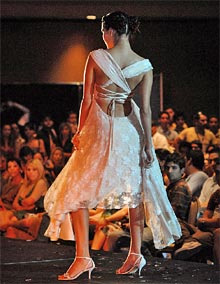
| | Model Cinthya Barragán displayed a dress by Tijuana fashion designer Ximena Valero during the show at the Grand Hotel. (David Maung/Union-Tribune) | 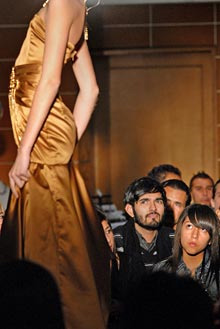
| | Fernanda Valdez (lower right) watched a model show off a dress by Iván Rodríguez during the show at the Marriott in Tijuana. (David Maung/Union-Tribune) |
To cope with this reality, Sanchez opened Retro Boutique, where he sells his most affordable designs (ranging from $25 for a shirt to $120 for a dress). At his workshop, he caters to customers who can afford his more exclusive creations, which run from $200 to $400.

“The competition in the market is tougher here,” says Sanchez, whose professional career goes back 10 years.

Valero doesn't have formal distribution of her designs in Tijuana. North of the border she can charge twice as much: $600 to $1,200 an item. She's looking for a boutique in San Diego to carry her designs.

“It's expensive. That's why it doesn't make sense for me to sell in Tijuana,” she says.

In fact, the dearth of opportunities for growth is one of the reasons Valero, 30, decided to leave Tijuana.

She studied fashion in Los Angeles and spent eight years in New York, Los Angeles and Mexico City. About eight months ago, she returned to Tijuana to see her family. She plans to go back to Los Angeles in January.

“I left Tijuana because my dream is to sell my designs in five continents, and you can't do that from here.

“But if your goal is to stand out on a regional basis, you can do it in Tijuana,” says Valero, who in April received an award for excellence in evening wear at Miami Fashion Week, an event that attracts the best Latin American designers.

Although Valero has become known across Mexico and abroad, she still participates in regional events.

“But I never forget where I came from,” she says. “It's the only time I can take a bow on the catwalk and see my family and friends seated among the public.”

And since she returned to Tijuana, Valero has made use of local maquiladora labor.

“Besides being more economical, I help to generate jobs in the city.”

She says it's an honor to be able to inspire other local designers who are just starting out.

“It helps to motivate young Tijuana designers,” says María Eugenia Martínez, professor and coordinator of the fashion design program at the Universidad de las Californias, the only university that offers such a degree in Tijuana.

Some of her students participated alongside Valero in Tijuana Fashion Week, held last month. The department has graduated about 50 designers since its founding 10 years ago. It has some 60 students enrolled in its bachelor's program.

Martinez says most of the graduates open their own shops.

“They have to start their own business, create their own brand.”

And that's how the cycle of Tijuana goes on, with designers hiring models, many of them from Rene Tamayo's agency, to strut down the catwalks at local fashion shows.

“Little by little, the public is getting more interested in local fashion design,” Sanchez says. “It's a market that's discovering itself.”

Pablo Jaime Sainz: editorial(at)mienlace.com | 
 | |
 |



